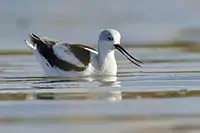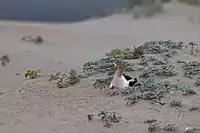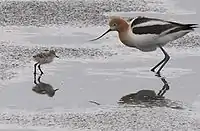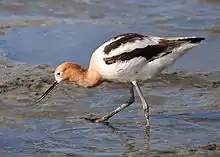American avocet
The American avocet (Recurvirostra americana) is a large wader in the avocet and stilt family, Recurvirostridae. This avocet spends much of its time foraging in shallow water or on mud flats, often sweeping its bill from side to side in water as it seeks its crustacean and insect prey.[2]
| American avocet | |
|---|---|
 | |
| Breeding plumage | |
| Scientific classification | |
| Kingdom: | Animalia |
| Phylum: | Chordata |
| Class: | Aves |
| Order: | Charadriiformes |
| Family: | Recurvirostridae |
| Genus: | Recurvirostra |
| Species: | R. americana |
| Binomial name | |
| Recurvirostra americana Gmelin, 1789 | |
 | |

Taxonomy and systematics
The American avocet is a bird in the order Charadriiformes, which includes shorebirds, gulls, and alcids. Its family - Recurvirostridae - includes stilts and avocets. The American avocet is one of four avocet species; the Andean avocet, the pied avocet, and the red-necked avocet are the remaining three species in the genus.[3]
Description
The American avocet measures 40–51 cm (16–20 in) in length, has a wingspan of 68–76 cm (27–30 in) and weighs 275–420 g (9.7–14.8 oz)[4][5] The bill is black, pointed, and curved slightly upwards towards the tip. It is long, surpassing twice the length of the avocet's small, rounded head. Like many waders, the avocet has long, slender legs and slightly webbed feet.[6] The legs are a pastel grey-blue, giving it its colloquial name, blue shanks. The plumage is black and white on the back, with white on the underbelly. During the breeding season, the plumage is brassy orange on the head and neck, continuing somewhat down to the breast. After the breeding season, these bright feathers are swapped out for white and grey ones.[7] The avocet commonly preens its feathers - this is considered to be a comfort movement.[2]
Distribution and habitat
American avocets were previously found across most of the United States until extirpated from the East Coast. The breeding habitat consists of marshes, beaches, prairie ponds, and shallow lakes in the mid-west, as far north as southern Canada.[4] These breeding grounds are largely in areas just east of the rocky mountains including parts of Alberta, Saskatchewan, Montana, Idaho, Washington, Utah, North and South Dakota, Nebraska, Colorado, and even down to parts of New Mexico, Oklahoma and Texas.[7] Their migration route lands them in almost every state in the western United States. The avocet's wintering grounds are mainly coastal. Along the Atlantic Ocean, they are found in North and South Carolina, Georgia and Florida. There are also wintering grounds along the Gulf of Mexico in Florida, Texas, and Mexico, and along the Pacific Ocean in California and Mexico. There are resident populations in the Mexican States of Zacatecas, San Luis Potosí, Guanajuato, Hidalgo, Mexico City and Puebla, and in Central California.[7]
Behaviour and ecology
Vocalizations
The American avocet call has been described as both a shrill and melodic alarm bweet, which rises in inflection over time.[6][7][8]
Breeding
American avocets breed in anything from freshwater to hypersaline wetlands in the western and mid-west United States.[7][9] American avocets form breeding colonies numbering in dozens of pairs.[10] Throughout the breeding season, birds pair off in a series of copulatory displays.[7] After breeding, the birds gather in large flocks, sometimes amounting to hundreds of birds. Nesting takes place near water, usually on small islands or mucky shorelines where access by predators is difficult. Together, the male and female build a saucer-shaped nest, take turns incubating the four eggs, and tending to the precocial young.[7] Upon hatching, the chicks feed themselves; they are never fed by their parents.[10]
Food and feeding
Avocets tend to prefer habitats with fine sediments for foraging.[11] In the winter, these birds feed extensively on brine shrimp. Usually, this entails the avocet pecking while walking or wading on the shore, but it can also swim to expand foraging area. During the breeding season, avocets continue to eat brine shrimp but switch mainly to consuming brine flies. Brine flies and brine fly larvae are so abundant in avocet breeding grounds that they often blacken the surface of any exposed mud. Brine flies sustain the avocet during its breeding season.[2] The avocet employs both visual and tactile methods of feeding.[7] The primary visual feeding method is pecking at flies. However the avocet will also feed by plunging (wherein the head and neck of the bird are submerged), snatching (wherein the bird catches a flying insect), and bill pursuit (wherein the bird repeatedly opens and closes its bill while moving its head along the surface of the water). Methods of tactile feeding include filtering, scraping, and scythe feeding.[2]
Threats
Shooting and trapping of American avocets led to population decline until the 1900s. During this time, the species was extirpated from most of the East Coast of the United States.[7] By 1918, Avocets became protected under the Migratory Bird Treaty Act (16 U.S.C. 703-712). Since that time, other threats have emerged. Contaminants and toxins such as DDT, selenium, and methylmercury, have had significant impacts on American avocet breeding success, especially because Avocet chicks are more susceptible to environmental disruptions than adults.[7][9] The avocet also faces habitat loss. While agricultural and industrial environments have become alternate habitat for the avocet, natural wetlands are decreasing rapidly.[7]

In culture
Art
In his famous The Birds of America, John James Audubon describes a day of stalking and spying on the avocet. He judiciously noted their foraging, nesting, defensive, and flight behaviors.[6] See his painting to the right.
Protected status
The American avocet is protected under the Migratory Bird Treaty Act of 1918.[12]
Gallery
 Winter plumage
Winter plumage Nesting
Nesting Nest with eggs
Nest with eggs Adult with a chick at Palo Alto Baylands Nature Preserve, California
Adult with a chick at Palo Alto Baylands Nature Preserve, California Breeding plumage
Breeding plumage Quintana, Texas. Winter
Quintana, Texas. Winter
References
- BirdLife International (2016). "Recurvirostra americana". IUCN Red List of Threatened Species. 2016: e.T22693717A93418724. doi:10.2305/IUCN.UK.2016-3.RLTS.T22693717A93418724.en. Downloaded on 17 February 2018.
- Hamilton, Robert Bruce (1975). "Comparative Behavior of the American Avocet and the Black-Necked Stilt (Recurvirostridae)" (PDF). Ornithological Monographs: iii-98. JSTOR 40166701.
- "Recurvirostra Linnaeus, 1758". the Integrated Taxonomic Information System on-line database. Retrieved 2017-10-17.
- "American Avocet, Identification". allaboutbirds.org. The Cornell Lab of Ornithology, Cornell University.
- "American Avocet". seaworld.org. SeaWorld. Archived from the original on 2013-07-31.
- Audubon, John James (1861). The birds of America : from drawings made in the United States and their territories. 6. New York. pp. 24–30.
- Ackerman, Joshua; Hartman, Alex; Herzog, Mark; Takekawa, John; Robinson, Julie; Oring, Lewis; Skorupa, Joseph; Boettcher, Ruth (2013). "American Avocet (Recurvirostra americana)". The Birds of North America. Ithaca, New York, USA: Cornell Lab of Ornithology. doi:10.2173/bna.275. Retrieved 2017-10-17.
- "Plovers, Oystercatchers, and Stilts". Larkwire. 2017. Retrieved 2017-10-17.
- Hannam, Kristina M.; Oring, Lewis W.; Herzog, Mark P. (2003). "Impacts of Salinity on Growth and Behavior of American Avocet Chicks". Waterbirds: The International Journal of Waterbird Biology. 26: 119–125. doi:10.1675/1524-4695(2003)026[0119:iosoga]2.0.co;2. JSTOR 1522475.
- "American Avocet Fact Sheet, Lincoln Park Zoo" Archived July 19, 2011, at the Wayback Machine
- Danufsky, Tamar; Colwell, Mark A. (2003). "Winter Shorebird Communities and Tidal Flat Characteristics at Humboldt Bay, California". The Condor. 105: 117–129. doi:10.1650/0010-5422(2003)105[117:wscatf]2.0.co;2. JSTOR 1370610.
- Migratory Bird Treaty
- O'Brien, Michael, et al. (2006). The Shorebird Guide. New York: Houghton Mifflin. ISBN 0-618-43294-9
External links
| Wikimedia Commons has media related to Recurvirostra americana. |
| Wikispecies has information related to Recurvirostra americana. |
- American avocet - Recurvirostra americana - USGS Patuxent Bird Identification InfoCenter
- American avocet species account – Cornell Lab of Ornithology
- "American avocet media". Internet Bird Collection.
- American avocet photo gallery at VIREO (Drexel University)
- Interactive range map of Recurvirostra americana at IUCN Red List maps
